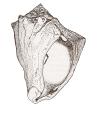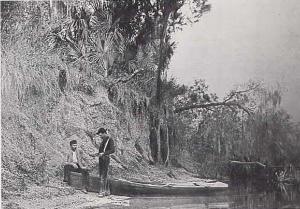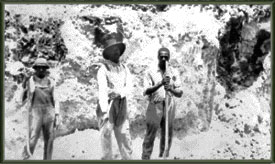Tick Island Burials
Six thousand years ago, the St. Johns River valley was home to a fairly large population, as attested by freshwater shell mounds dotting the riverbanks. Some of these sites later caught the eyes of 19th and 20th century investigators.
|
On Tick Island (which is not developed for visitors), researchers have found a large sand mound that served as a major burial site. Excavations in the 1960s by Ripley Bullen revealed single, double, and multi-person graves - altogether 175 burials. Anthropologists theorize that the bodies were stored temporarily, until burial time, at a charnel house to protect them from the elements and from animals. An area next to the mound may have been used for ritual feasting. |
|
The graves at Tick Island contained ceremonial antler headgear, remains of feasts for the dead, and projectile points and knives. The latter may have been meant to accompany the departed... or they many have caused the deaths. Several people buried here had been killed by spear points.
The first landfills
| Middens in east Florida consist mainly of discarded shells, but also of animal bones, broken tools, pottery fragments, charcoal from cookingand more. Researchers have been able to identify the animals and plants (evidence of people's diet) and to use charcoal and shells for carbon dating. At some sites, ornamental objects, glass beads, and other artifacts show that the area's residents traded not only with European invaders, but with native people from across the Southeast. |
 Cutting edge tool Cutting edge toolThe Florida Anthropologist June-September 2000 |

Shell mound near Hontoon Island
Florida State Archives
Inside the mounds
The contents of this region's middens are revealing. First, although the quantity of shells seems to point to shellfish as the primary food, thousands of small fish bones show another vital part of people's diets. Second, the range of animal bones here indicates that natives hunted virtually everything living in the area. Along with alligator and fish, the people consumed an amazing variety of animals, including:
| Animals consumed by Volusia County Natives | ||
| deer | rabbits | pondsnails |
| dams | toads | frogs |
| box turtles | gopher tortoises | black snakes |
| rat snakes | water moccasins | rattlesnakes |
| white ibis | sandhill cranes | coots |
| egrets | herons | eagles |
| turkeys | black bears | panthers |
| muskrats | squirrels | skunks |
| oppossums | moles | hammerhead sharks |
| mako sharks | giant sea turtles | |
Plants also were important in the diets of native people, but plant remains usually are not well preserved in middens. One exception is a site at Hontoon Island excavated by Barbara Purdy, with the University of Florida, who found identifiable plant and wood remains in a wetland midden next to a village site.
In addition to local species like cypress, pine, bay, cedar, and oaks, the Hontoon Island midden yielded evidence of tropical woods not native to Florida. Thirty species of preserved wood and 82 types of seed or plant parts were identified. Some of the many plants found there were used as food, including hickory nuts, acorns, cabbage palm, wild grape, saw palmetto, huckleberry, blueberry, elderberry, black gum, groundcherry, and pokeweed.
What about corn? It was not identified at Hontoon Island because the site's Mayaca people did not grow corn. To the north, Timucuans did cultivate subsistence crops such as corn, beans, and peas, but East-central Florida did not have the fertile soils needed to sustain agriculture as it was practiced in areas like Florida's panhandle. Besides, the country here already provided a natural bounty for people fishing, hunting, and gathering.
Losing the past
In 1875, when Harvard archaeologist Jeffries Wyman reported his St. Johns River work, he noted mound sites in Volusia County including Volusia (west of DeLeon Springs), Tick Island (at Lake Woodruff), Hontoon Island, and Blue Springs. He also had examined a large freshwater snail midden at Old Enterprise - a mound large enough to provide the footing for one of Florida's first tourist hotels.
Ten years later, the Enterprise mound was mostly gone. It it had been dug out to make roads and to fertilize orange groves, and in the 1920s it was further destroyed for use as county road fill.

1920 Enterprise Shell Mound
Florida State Archives
Old Enterprise is not an isolated case. In fact, many East Florida shell mounds have been largely or completely removed - not only for roads, but for railway track building and street work in new towns along the lines. As one archaeologist began noticing early here, "Part of Volusia County's prehistory is scattered as far south as Palm Beach."
Saving the story

There are successes in finding, preserving, and understanding evidence of East Florida's native inhabitants. Turtle Mound, the largest shell mound in the United States, and Ormond Burial Mound, in Ormond Beach, were saved through the efforts of residents who saw their value; and other prehistoric sites in Volusia County ar
e now held by local, state, and federal government agencies. The work of exploring and explaining them goes on, and the 20th Century has seen major finds. In 1955, a dragline operation at Hontoon Island, on the St. Johns River near Blue Spring, uncovered a 12-foot-tall owl totem carved from pine.
The same area also has yielded other animal carvings, including a 400-pound pelican. Shaped by shark's-tooth knives and shell tools, they are more than six centuries old.

